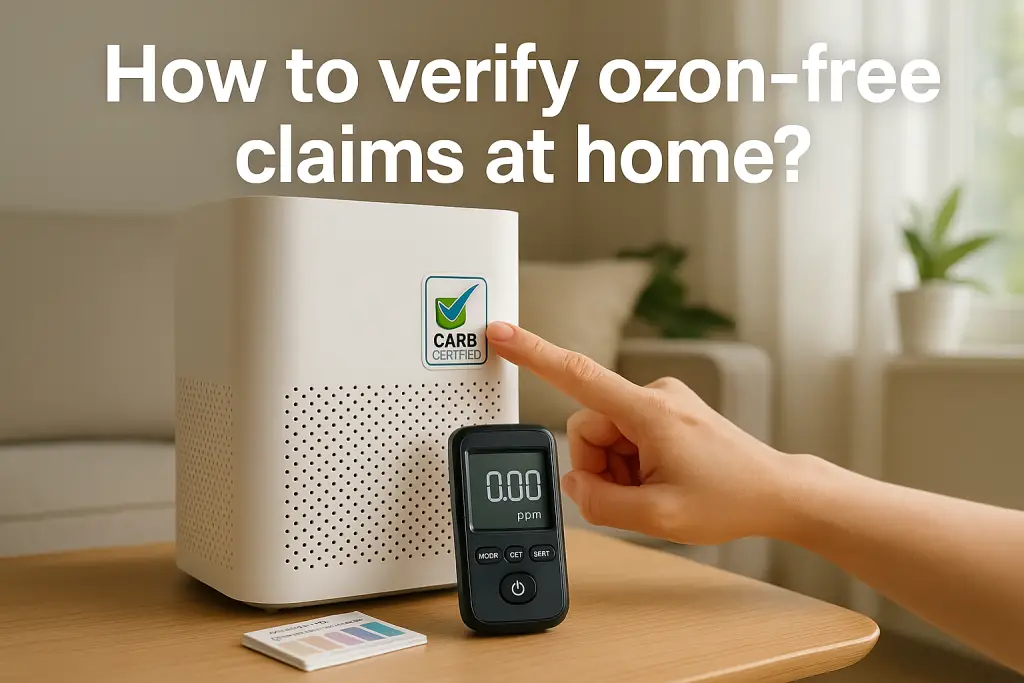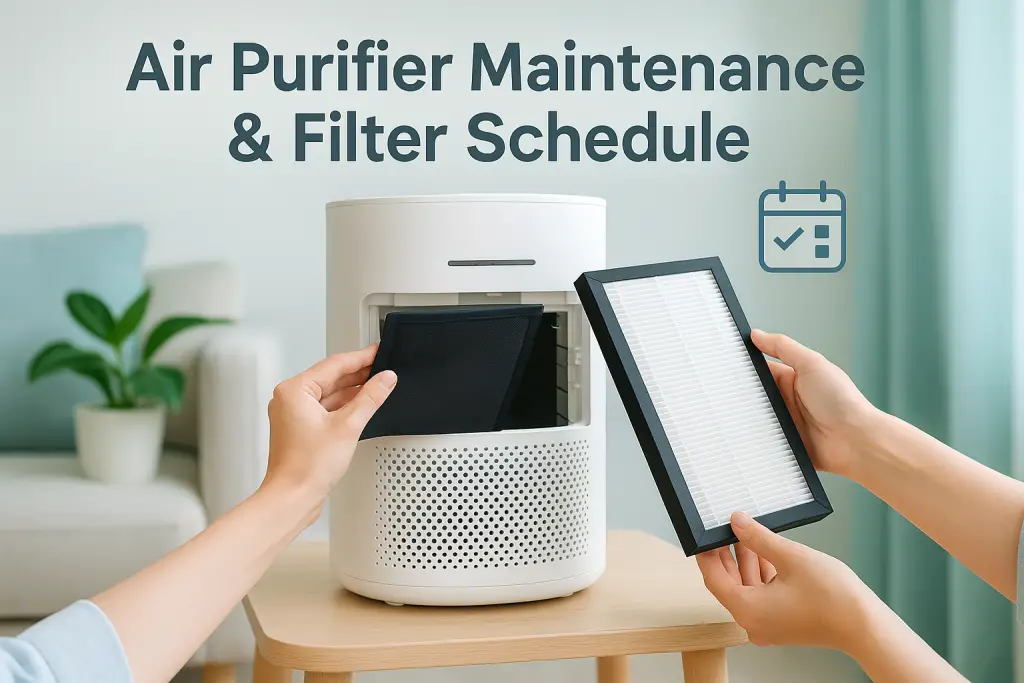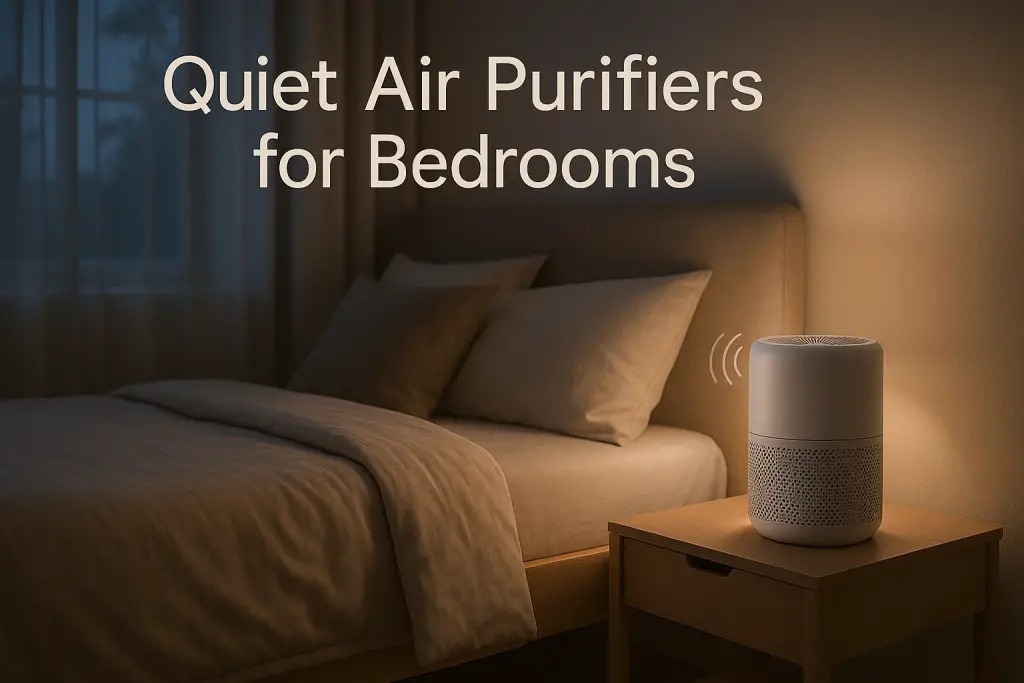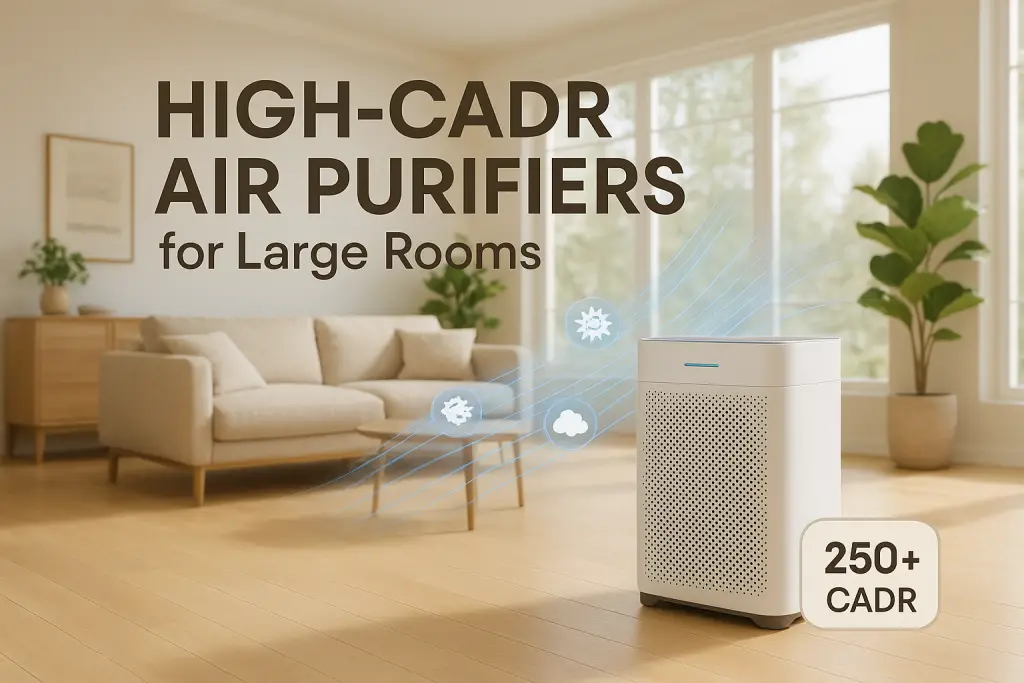Verifying ozone-free claims for air purifiers is essential for protecting your health at home. Many manufacturers advertise their products as “ozone-free,” but these claims aren’t always accurate. This guide provides seven reliable methods to check if your air purifier truly produces zero ozone, ranging from free visual inspections to affordable testing kits and professional verification options. With rising concerns about indoor air quality, knowing how to verify these claims helps you make informed decisions based on EPA and CARB standards rather than marketing promises.
Understanding Ozone and Air Purifiers: What You Need to Know First
Before attempting to verify ozone-free claims, it’s essential to understand what ozone is, how air purifiers might produce it, and why it matters for your health. Ozone (O₃) is a molecule consisting of three oxygen atoms. While beneficial in the upper atmosphere, ground-level ozone irritates the respiratory system and can worsen asthma and other lung conditions.
Some air purifiers generate ozone either intentionally or as a byproduct of their cleaning process. The health impacts vary based on concentration levels:
- 0.05 ppm: California Air Resources Board (CARB) limit for devices
- 0.07 ppm: EPA’s outdoor air quality standard
- 0.08-0.10 ppm: Respiratory irritation begins for sensitive individuals
- Above 0.10 ppm: Increasing respiratory distress for general population
Be cautious of misleading marketing terms like “activated oxygen,” “super oxygen,” or “energized oxygen” – these are often euphemisms for ozone. A truly “ozone-free” air purifier should produce less than 0.05 parts per million of ozone, which is the CARB limit for acceptable ozone emission levels from air cleaning devices.
Technologies That Commonly Produce Ozone: Know What to Look For
Certain air purification technologies are known to generate ozone, either as a byproduct or intentionally. Identifying these technologies is your first step in verification.
| Technology | Ozone Risk Level | How It Works |
|---|---|---|
| Ionizers/Negative Ion Generators | Medium-High | Release charged particles that can produce ozone |
| Electrostatic Precipitators | Low-Medium | Use electrical charges that can create ozone as a byproduct |
| UV Light Systems | Low-Medium | Some wavelengths can convert oxygen to ozone |
| Ozone Generators/Ozonators | High (intentional) | Deliberately produce ozone as primary cleaning method |
| PCO/Photocatalytic Oxidation | Low-Medium | May produce ozone during oxidation process |
| HEPA Filtration | None | Mechanical filtration only, no ozone production |
| Activated Carbon Filtration | None | Chemical adsorption, no ozone production |
Visual clues that might indicate ozone-producing technology include electrode wires, metal collection plates, or UV light components without proper shielding. If you’re looking to avoid ozone completely, choosing air purifiers with HEPA and activated carbon filtration offers the safest approach.
Method 1: Visual Inspection and Technology Identification
The simplest and completely free way to begin verifying ozone-free claims is through careful visual inspection of your air purifier’s design, marketing materials, and technical specifications.
Follow this step-by-step checklist for thorough visual inspection:
- Examine technology labels: Look for keywords like “ionizer,” “plasma,” “electrostatic,” “PCO,” or “UV” on the box or in product descriptions.
- Check physical components: Look for thin wires, metal plates, or visible UV bulbs that indicate potential ozone-producing technologies.
- Review control options: If there’s an “ionizer on/off” switch or similar control, the device contains an ozone-producing component.
- Study the manual: Search for warnings about ozone production or statements like “may produce trace amounts of ozone.”
- Look for certifications: CARB certification stickers or UL 2998 (zero ozone) certification provide some assurance.
Red flag phrases in marketing materials include:
- “Sanitizes air” (without specifying filtration method)
- “Purifies air without filters” (often indicates ionization)
- “Electrically charges particles” (suggests ionization)
- “Energized oxygen” or “activated oxygen” (euphemisms for ozone)
Visual inspection gives you initial information but often needs to be combined with other verification methods for conclusive results.
Method 2: Understanding and Verifying Certification Claims
Many air purifiers claim various certifications regarding ozone emissions. Knowing how to verify these certification claims can provide significant peace of mind without requiring any testing equipment.
Major certifications related to ozone production include:
- CARB Certification: The California Air Resources Board certifies that devices emit less than 0.05 ppm of ozone.
- AHAM Verifide: The Association of Home Appliance Manufacturers tests for performance but doesn’t specifically focus on ozone (though certified models typically comply with ozone limits).
- UL Standards: UL 867 limits ozone but still allows some production, while UL 2998 certifies “zero ozone emission” (less than 0.005 ppm).
- Energy Star: Requires that products meet ozone emission standards to qualify.
To verify certification claims, follow these steps:
- Locate certification marks on the device, packaging, or in the manual.
- Check certification databases on official websites:
- CARB-certified devices: https://ww2.arb.ca.gov/list-carb-certified-air-cleaning-devices
- AHAM-verified products: https://www.ahamverifide.org/directory-of-certified-products/
- Verify certification numbers match those on the product.
- Understand certification scope – some only apply to certain operating modes or settings.
Be aware that some manufacturers use misleading “certification-like” symbols or make vague claims like “tested for safety.” For reliable verification, look for specific certification numbers and symbols that indicate compliance with ozone-free standards.
Method 3: The Smell Test and Common Misconceptions
While many users attempt to detect ozone through smell, this method has significant limitations and common misconceptions that must be understood.
Ozone has a distinctive smell often described as “clean,” “electrical,” or similar to the air after a thunderstorm. However, the smell test is problematic for several reasons:
- Ozone detection thresholds vary widely between individuals (0.01-0.04 ppm).
- Olfactory fatigue sets in quickly, making continuous detection difficult.
- Other VOCs and emissions can smell similar to ozone, causing confusion.
- By the time you can smell ozone, levels may already exceed health guidelines.
If you still want to try a more reliable smell test:
- Prepare the room: Remove scented products and ensure good ventilation initially.
- Establish a baseline: Note how the room smells with the purifier off.
- Run on highest setting: Operate the purifier at maximum for 1-2 hours in a closed room.
- Check for changes: A sharp, clean, electrical smell may indicate ozone.
According to Dr. Richard Shaughnessy, Director of Indoor Air Research at University of Tulsa, “The human nose is not reliable enough to serve as a primary ozone detector. Levels that can cause respiratory issues may be below the detection threshold for many people.”
While the smell test provides a free initial assessment, you’ll need more objective methods for accurate verification.
Method 4: Using Ozone Test Cards and Color-Change Indicators
Ozone test cards and color-change indicators provide an affordable entry point for objective ozone detection, available for under $30. These simple tools change color when exposed to ozone, giving visual confirmation of its presence.
Popular ozone detection products include:
| Product | Price Range | Detection Range | Response Time |
|---|---|---|---|
| EcoSensor OzoneCheck Cards | $15-25 | 0.05-0.1 ppm | 10-15 minutes |
| Dragier Ozone Detection Tubes | $25-35 | 0.05-1.0 ppm | 5-10 minutes |
| Industrial Test Systems OzoCheck | $20-30 | 0.02-0.15 ppm | 15-30 minutes |
| ZerO3 Test Strips | $15-20 | 0.03-0.10 ppm | 15 minutes |
To use ozone test cards effectively:
- Prepare the testing area: Close windows and doors in a small room (under 200 sq ft ideal).
- Place test cards correctly: Position 2-3 feet from the purifier and away from direct airflow.
- Run the purifier: Operate on highest setting with all features activated for at least 1-2 hours.
- Check for color change: Compare against the reference chart (typically blue/purple indicates ozone presence).
- Document results: Take photos of the cards next to the reference chart for documentation.
Limitations of this method include potential false positives from other oxidizing gases and limited precision in measurement. However, for most home users, these cards provide a reasonable first line of objective testing.
Method 5: Consumer-Grade Ozone Meters and Air Quality Monitors
For more precise measurements, consumer-grade ozone meters and multi-pollutant air quality monitors provide digital readings that can verify ozone production with greater accuracy.
Available options range widely in price and capability:
| Category | Price Range | Examples | Features | Accuracy |
|---|---|---|---|---|
| Budget Options | $50-100 | Temtop M10, Huma-i HI-150 | Basic ozone detection, limited features | ±0.01-0.02 ppm |
| Mid-Range Options | $100-250 | Temtop M2000, Airthings View Plus | Multiple pollutant tracking, app connectivity | ±0.01 ppm |
| Premium Options | $250-500 | uHoo, IQAir AirVisual Pro | Professional-grade sensors, data logging, alerts | ±0.005 ppm |
To properly test your air purifier with a consumer-grade meter:
- Establish baseline readings: Measure ambient ozone levels before turning on the purifier.
- Position the meter correctly: Place 3-6 feet from the purifier in its typical operating location.
- Run a timed test: Operate the purifier for at least 4 hours on highest settings with all features active.
- Document multiple readings: Take measurements every 30-60 minutes to track changes.
- Compare to standards: CARB limit is 0.05 ppm; if readings exceed this, the device isn’t truly ozone-free.
According to air quality specialist James Davis, “Consumer-grade monitors have improved dramatically in recent years, but they still have a margin of error of about ±0.005-0.02 ppm depending on the model. For most home users, this accuracy is sufficient to identify problematic purifiers.”
If you’re sizing a new air purifier for your space, ensure that the proper air purifier dimensions match your room size for optimal performance without overtaxing the unit.
Method 6: Professional Testing Services and When to Use Them
In some situations, particularly for those with severe respiratory conditions or when legal verification is needed, professional testing services provide the gold standard for ozone verification.
Consider professional testing when:
- You have severe asthma, COPD, or other respiratory conditions
- You need documentation for legal disputes (rental properties, product returns)
- Your home tests show borderline results
- Multiple family members experience symptoms that suggest ozone exposure
- You need precise measurements beyond consumer device capabilities
Professional testing options include:
- Indoor Air Quality (IAQ) Consultants: Specialize in comprehensive home air testing ($200-400)
- Industrial Hygienists: Certified professionals with advanced equipment ($300-500)
- Environmental Testing Firms: Companies with laboratory-grade monitoring equipment ($250-450)
During professional testing, expect:
- Initial consultation and home inspection
- Placement of calibrated monitoring equipment
- Controlled testing over 4-24 hours
- Detailed written report with precise measurements
- Recommendations based on findings
To find qualified testing services, contact your local health department, check with the Indoor Air Quality Association (IAQA), or ask for referrals from environmental medicine specialists.
Method 7: Innovative Approaches and Community Resources
Beyond standard testing methods, several innovative and community-based approaches can help verify ozone-free claims without significant expense.
Community-based resources to consider:
- University extension programs: Many state universities offer free or low-cost testing through their extension services.
- Library loan programs: Some public libraries now loan air quality monitoring equipment just like books.
- Community science projects: Participate in local air quality monitoring networks that may provide equipment and expertise.
- Maker spaces: Community workshops sometimes have air quality monitors available for member use.
Smart home integration options:
- Smart air quality monitors that connect to home automation systems
- Continuous data logging apps that can track patterns over time
- Community databases where users share test results for specific models
The Purple Air network and similar citizen science initiatives have created maps where community members share air quality data, sometimes including ozone readings. These resources can help identify trends and problems in specific areas or with specific devices.
For reference and community input, check online forums like Reddit’s r/airpurifiers where users share their experiences with various air purifiers’ effectiveness against particles like dust and pollen as well as potential ozone issues.
Special Considerations for Sensitive Individuals and Spaces
Certain individuals and environments require special attention when verifying ozone-free claims due to increased sensitivity or unique circumstances.
For People with Respiratory Conditions
If you have asthma, COPD, or other respiratory sensitivities:
- Use multiple verification methods rather than relying on just one
- Set lower acceptable thresholds (aim for 0.03 ppm or less rather than the 0.05 ppm standard)
- Test at both high and low fan speeds, as ozone production can vary
- Keep detailed symptom journals to correlate with purifier usage
For Households with Children
Children are more sensitive to ozone due to their developing respiratory systems:
- Focus on mechanical filtration methods (HEPA) rather than electronic air cleaning
- Test in children’s rooms specifically, as they often spend more time there
- Use lower height placement for test equipment to match children’s breathing zone
For Rental Properties
If you’re in a rental situation:
- Use non-damaging, temporary testing methods like cards or portable meters
- Document all test results with photos or screenshots
- Communicate findings with landlords using test documentation
- Know local regulations regarding air quality in rental properties
According to Dr. Elizabeth Peterson, pulmonologist, “For patients with existing respiratory conditions, even ozone levels below regulatory limits can trigger symptoms. I recommend my patients use only mechanical filtration methods that physically cannot produce ozone.”
Seasonal and Environmental Factors Affecting Ozone Detection
Various environmental and seasonal factors can significantly impact ozone readings and must be considered when verifying ozone-free claims at home.
Ambient outdoor ozone levels vary by season:
- Summer: Typically highest (0.03-0.08 ppm in many urban areas) due to heat and sunlight
- Spring/Fall: Moderate levels (0.01-0.04 ppm)
- Winter: Typically lowest (0.01-0.02 ppm)
Environmental factors affecting readings include:
- Temperature: Higher temperatures can increase ozone production in electronic devices
- Humidity: High humidity may reduce detected ozone as water molecules react with it
- Ventilation: Poor ventilation concentrates ozone, while excessive airflow dilutes readings
- Other pollutants: VOCs and NOx can interact with ozone, affecting measurements
For maximum accuracy, test during different conditions:
- Morning vs. evening (temperature differences)
- Different seasons if possible
- Both high and low humidity days
What to Do If You Discover Your “Ozone-Free” Purifier Produces Ozone
If your testing reveals that an air purifier marketed as “ozone-free” actually produces ozone, here’s a systematic approach to addressing the situation.
Immediate safety steps:
- Turn off the device and unplug it
- Ventilate the space by opening windows for at least 30 minutes
- Relocate sensitive individuals (children, elderly, those with respiratory conditions) temporarily
- Document your findings with photos, videos, or test results
Next steps based on your situation:
- Recent purchase (under 30 days): Contact retailer for immediate return/refund
- Warranty period: File warranty claim citing false advertising
- Outside warranty: Consider consumer protection complaint
How to file complaints:
- Retailer: Submit complaint through customer service with test documentation
- Manufacturer: Submit formal complaint with test results and product information
- Federal Trade Commission (FTC): File false advertising complaint at ftc.gov/complaint
- CARB: California residents can report non-compliant devices to CARB enforcement
- Consumer Product Safety Commission: Report potential safety hazards
Sample complaint letter template:
“I purchased [Product Name, Model] on [date] from [retailer] based on claims that it was ‘ozone-free.’ Testing conducted on [date] using [testing method] showed ozone levels of [reading] ppm, which exceeds CARB limits of 0.05 ppm. I request [specific resolution] based on this false advertising. Documentation of my testing is attached.”
Understanding how to identify misleading environmental claims in air quality products can help you make more informed choices and avoid greenwashed products in the future.
Choosing Truly Ozone-Free Air Purifier Technologies: A Buyer’s Guide
Based on verification research and testing, certain air purification technologies consistently deliver on ozone-free claims, providing cleaner air without potentially harmful byproducts.
| Technology | Ozone Risk | Effectiveness For | Limitations |
|---|---|---|---|
| True HEPA Filtration | None | Particles, allergens, dust | No gas/odor removal, filters need replacement |
| Activated Carbon | None | Odors, VOCs, gases | Limited particle removal, needs replacement |
| Combination HEPA + Carbon | None | Particles and gases | Higher cost, regular filter replacement |
| UV-C (with proper shielding) | Minimal/None when properly designed | Bacteria, viruses | Limited particle removal, bulbs need replacement |
Features that indicate truly ozone-free operation:
- Clear identification of mechanical filtration methods
- CARB compliance stated explicitly
- UL 2998 certification (zero ozone standard)
- Detailed specifications about filtration rather than vague “purification” claims
- No mentions of ionization, plasma, or electronic cleaning (unless explicitly certified ozone-free)
Red flags in marketing materials:
- Claims of “No filters needed” or “Never replace filters”
- Vague terms like “advanced oxidation” without explanation
- Focus on “killing” bacteria or viruses rather than removing them
- Excessive claims about effectiveness without scientific backup
According to Dr. Jeffrey Williams, environmental engineer, “The most reliable ozone-free technologies remain mechanical filtration methods like HEPA and activated carbon. These physically cannot produce ozone due to the nature of their operation.”
Before investing in a new purifier, you can check the accuracy of CADR (Clean Air Delivery Rate) claims to ensure you’re getting effective air cleaning without ozone risks.
Conclusion: Developing Your Verification Strategy
Verifying ozone-free claims doesn’t require a single approach but rather a verification strategy tailored to your specific situation, concerns, and resources. Start with the simplest methods like visual inspection and certification verification, then progress to more sophisticated testing if needed.
The most effective approach combines multiple methods:
- Free methods: Visual inspection, certification verification
- Low-cost options: Ozone test cards, community resources
- Moderate investment: Consumer-grade monitors
- High-concern situations: Professional testing
Remember that protecting your respiratory health is worth the effort of verification. Even purifiers marketed as high-end or premium products can produce ozone if they use certain technologies.
Dr. Maria Chen, indoor air quality researcher, summarizes it well: “The gap between marketing claims and actual performance remains significant in the air purifier industry. Verification isn’t just for peace of mind – it’s an essential step for protecting respiratory health, especially for sensitive individuals.”
| Photo | Air Purifier Model | Best for | Price |
|---|---|---|---|

|
WINIX A231 Air Purifier | Asthma & Indoor Pollution | Check Price On Amazon |

|
Rabbit Air, A3 SPA-1000N Air Purifier | Pet Dander & Odors | Check Price On Amazon |

|
LEVOIT Air Purifier | Best Overall | Check Price On Amazon |

|
GermGuardian Air Purifier | Cigarette & Cooking Smoke | Check Price On Amazon |

|
Coway Airmega Air Purifier | New-borns | Check Price On Amazon |

|
BLUEAIR Air Purifier | Germ & Virus Control | Check Price On Amazon |






